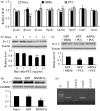DNMT3a contributes to the development and maintenance of bone cancer pain by silencing Kv1.2 expression in spinal cord dorsal horn
- PMID: 29056068
- PMCID: PMC5676500
- DOI: 10.1177/1744806917740681
DNMT3a contributes to the development and maintenance of bone cancer pain by silencing Kv1.2 expression in spinal cord dorsal horn
Erratum in
-
Corrigendum to "DNMT3a contributes to the development and maintenance of bone cancer pain by silencing Kv1.2 expression in spinal cord dorsal horn".Mol Pain. 2020 Jan-Dec;16:1744806920963460. doi: 10.1177/1744806920963460. Mol Pain. 2020. PMID: 35856160 Free PMC article. No abstract available.
Abstract
Metastatic bone tumor-induced changes in gene transcription and translation in pain-related regions of the nervous system may participate in the development and maintenance of bone cancer pain. Epigenetic modifications including DNA methylation regulate gene transcription. Here, we report that intrathecal injection of decitabine, a DNA methyltransferase (DNMT) inhibitor, dose dependently attenuated the development and maintenance of bone cancer pain induced by injecting prostate cancer cells into the tibia. The level of the de novo DNMT3a, but not DNMT3b, time dependently increased in the ipsilateral L4/5 dorsal horn (not L4/5 dorsal root ganglion) after prostate cancer cells injection. Blocking this increase through microinjection of recombinant adeno-associated virus 5 (AAV5) expressing Dnmt3a shRNA into dorsal horn rescued prostate cancer cells-induced downregulation of dorsal horn Kv1.2 expression and impaired prostate cancer cells-induced pain hypersensitivity. In turn, mimicking this increase through microinjection of AAV5 expressing full-length Dnmt3a into dorsal horn reduced dorsal horn Kv1.2 expression and produced pain hypersensitivity in the absence of prostate cancer cells injection. Administration of neither decitabine nor virus affected locomotor function and acute responses to mechanical, thermal, or cold stimuli. Given that Dnmt3a mRNA is co-expressed with Kcna2 mRNA (encoding Kv1.2) in individual dorsal horn neurons, our findings suggest that increased dorsal horn DNMT3a contributes to bone cancer pain through silencing dorsal horn Kv1.2 expression. DNMT3a may represent a potential new target for cancer pain management.
Figures






References
-
- Mantyh PW. Cancer pain and its impact on diagnosis, survival and quality of life. Nat Rev Neurosci 2006; 7: 797–809. - PubMed
-
- Bubendorf L, Schopfer A, Wagner U, et al. Metastatic patterns of prostate cancer: an autopsy study of 1,589 patients. Hum Pathol 2000; 31: 578–583. - PubMed
-
- Mercadante S. Malignant bone pain: pathophysiology and treatment. Pain 1997; 69: 1–18. - PubMed
-
- Gaskin DJ, Richard P. The economic costs of pain in the United States. J Pain 2012; 13: 715–724. - PubMed
-
- Clohisy DR, Mantyh PW. Bone cancer pain. Cancer 2003; 97: 866–873. - PubMed
Publication types
MeSH terms
Substances
Grants and funding
LinkOut - more resources
Full Text Sources
Other Literature Sources

